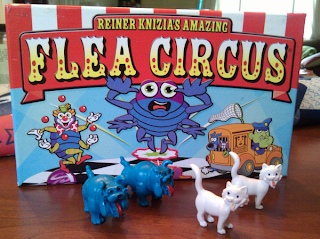Alex is four years old. For his birthday, we got him Flea Circus, a fun little card game by Reiner Knizia whose main appeal may be the little plastic dogs and cats that are included. They are the scoring mechanism for the game: dogs are worth two points and cats are worth one. At the beginning of the game, they are grouped in the middle of the table, and as you get acts for your flea circus, you take your points from the middle or sometimes from other players.
The first time we played the game, we explained to Alex how the scoring worked. Points are earned in the 1-4 range, and every time Alex earned points, he would take the appropriate number of cats. Once the cats were all gone, he was visibly confused over the value of the dogs, and we had to "make change" for him.
We put the game away for several weeks, wondering if perhaps the mathematics of the scoring was just a bit over his head. The manufacturer's suggested age is 6+ after all, and the BGG suggested age range is 5–12. When we got it back out and played a few times, Alex did not make a run on cats. He seemed to notice the patterns in how my wife and I scored our points: one was a cat; two was a dog; three was a cat and a dog; and four was two dogs. It was great to see that he had gotten the pattern, partially because it meant there was less fiddling with those awkward, easily-tipped cats. However, his was not a functional arithmetic abstraction, as once we were out of dogs, he was confused about how to count out three points again.
Flea Circus is a fine game, but it's not as much fun as Kinder Bunnies, which we got Alex for Christmas and is his go-to game. We play this game a lot. In fact, we made a scorecard of which is the magic carrot each game since we started playing:
As you can see, we have played 46 times, and Gilligan has proven himself most often to be the magic carrot. (As in Killer Bunnies, the premise of the game is that you acquire carrots, not knowing until the end of the game which is the magic, game-winning one.)
Some of the Kinder Bunnies cards are Bunny Bucks. These are used to activate some other cards, although usually you just hoard them since ten will buy a carrot. Bunny bucks come in different denominations: 1, 2, 5, and 10.
One of the cards allows you to spend five bucks to retrieve and play any card from the discard pile—especially useful when the coveted Take Two Carrots card has been played! Alex had never previously shown any savvy for arithmetic with Bunny Bucks, although he could recognize that the "5" card was enough to use the buyback, and that the "10" card could be used to buy a carrot. Given mixed denominations, though, we always had to point out to him what he could do with it.
On Saturday, we were playing in a group of five with my wife's parents. Alex had four "1" Bunny Bucks in front of him, and he asked if he had enough to use the buyback card. I spread out his cards and pointed out that each was worth one, then asked him to count them, and he noted that he had four. "Oh, so I need one more," said he, nonchalantly. "Yes, that's right," I responded.
That was the day that my son subtracted.



No comments:
Post a Comment